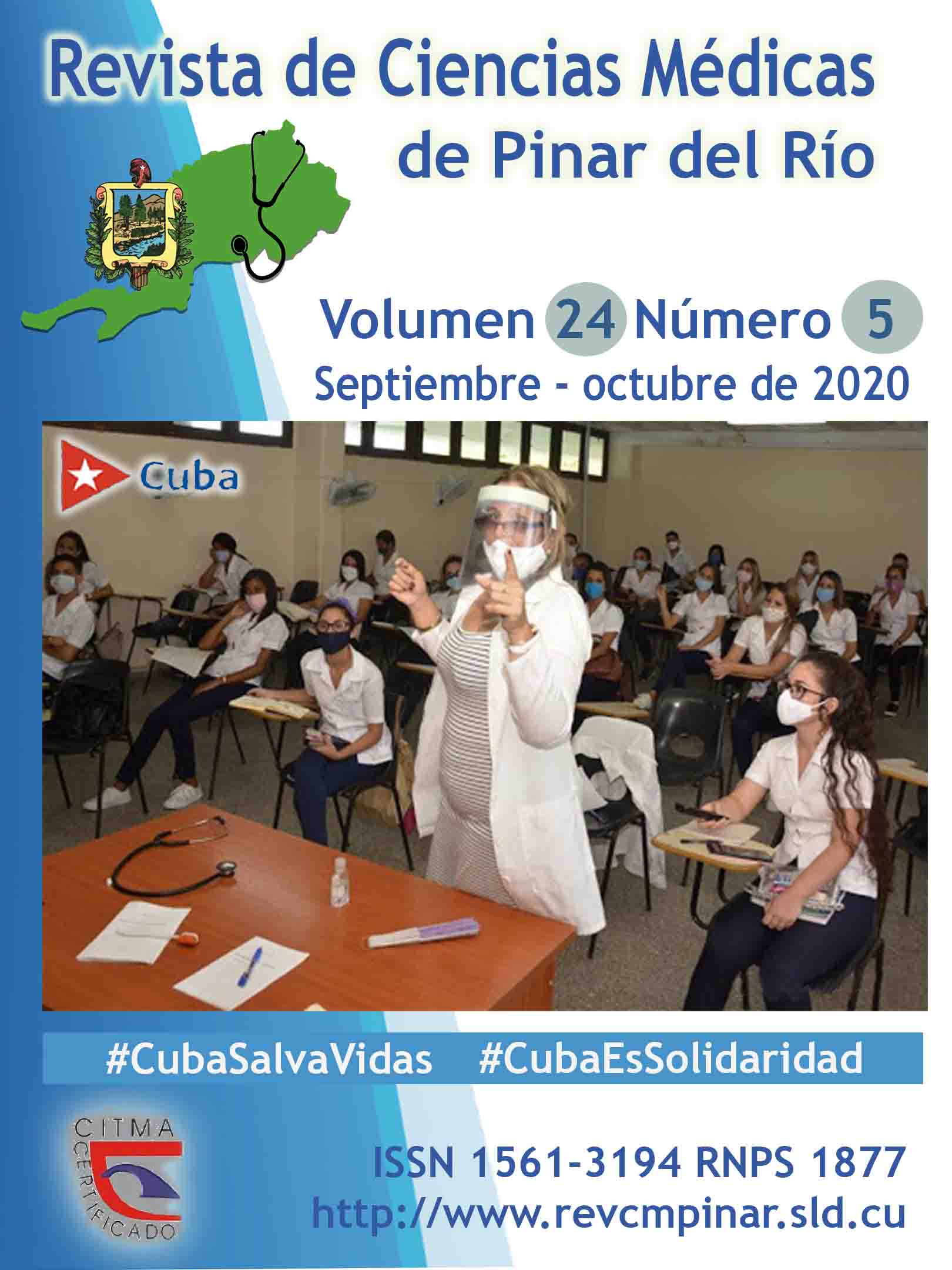Characterization of patients with chest trauma
Keywords:
THORAX/EPIDEMIOLOGY, ENTERAL NUTRITION.Abstract
Introduction: chest trauma is a serious health problem. It constitutes one of the most frequent emergencies and is among the most important causes of admission, with high percentages of mortality.
Objective: to characterize the patients admitted for thoracic trauma at Abel Santamaría Cuadrado General Teaching Hospital, in the period 2016-2018.
Methods: a descriptive, cross-sectional and observational study was conducted on patients admitted for thoracic trauma. The target group comprised 303 patients diagnosed and registered in the files of the center during the described period, and the sample included 301 cases. Descriptive and inferential statistical methods were applied.
Results: male sex predominated (94%), mean age was 46±17.03 years. Soft tissue lesions (36.9%) and intercostal neuritis (19.9%) prevailed; 21% required emergency surgery, where 27% presented complications. The average stay was 3.5 days/patient; the cost was 147,565.1 cup. An association was found between on time administration of early enteral nutrition and a shorter hospital stay.
Conclusions: male patients between the third and fourth decade of life were prone to suffer from chest trauma. Surgical interventions were necessary in a smaller percentage, showing few complications, with predominance of recurrent pneumothorax. Both early enteral nutrition as stays of less than four days, were frequent in these patients.
Downloads
References
1. Simon LV, Lopez RA, King KC. Blunt Force Trauma. In: StatPearls [Internet]. Treasure Island (FL): StatPearls Publishing; 2020 [citado 20/11/2019]. Disponible en: https://www.ncbi.nlm.nih.gov/books/NBK470338/
2. Herrera-Cartaya C, Bermúdez-Ruíz JA, Brunet-Liste JV, Luna-Capote AI. Caracterización del traumatizado severo en una Unidad de Cuidados Intensivos del Hospital Arnaldo Milián Castro. Univ Med Pinareña [Internet]. 2020 [citado 12/01/2020]; 16(1):e379. Disponible en: http://www.revgaleno.sld.cu/index.php/ump/article/view/379
3. González L, Riquelme A, Toloza C, Reyes R, Seguel E, Stockins A, et al. Traumatismo torácico contuso. Rev. chil. enferm. respir [Internet]. 2019 [citado 20/11/2019]; 35(2): 96-103. Disponible en: https://scielo.conicyt.cl/scielo.php?script=sci_arttext&pid=S0717-73482019000200096&lng=es
4. Zanette GZ, Waltrick RS, Monte MB. Perfil epidemiológico do trauma torácico em um hospital referência da Foz do Rio Itajaí. Rev. Col. Bras. Cir [Internet]. 2019 [citado 15/11/2019]; 46(2). Disponible en: http://www.scielo.br/scielo.php?script=sci_arttext&pid=S0100-69912019000200152&lng=en.
5. González Fernández AM, Torres Torres AR, Valverde Molina J. Traumatismo torácico, neumotórax, hemoptisis y tromboembolismo pulmonar. Protoc diagn ter pediatr [Internet]. 2017 [citado 15/11/2019]; 1: 189-209. Disponible en: https://www.aeped.es/sites/default/files/documentos/12_traumatismo_toracico.pdf
6. Sibaja Matamoros DA. Trauma de tórax: fisiopatología y manejo del tórax inestable con contusión pulmonar. Rev. Méd. costa cen [Internet]. 2015 [citado 15/11/2019]; LXXI(617): 687–693. Disponible en: https://www.medigraphic.com/pdfs/revmedcoscen/rmc-2015/rmc154b.pdf
7. Mogollón Guzmán EA, Estrada Cherres JP, Rincones Patiño EG, Ulloa Castro AF. Trauma de tórax en el servicio de emergencia del Hospital Vicente Corral Moscoso, Cuenca. Ecuador. Rev Arbit Interd Cien Salud [Internet]. 2019 [citado 15/11/2020]; 3(6): 217-224. Disponible en: https://dialnet.unirioja.es/descarga/articulo/7097522.pdf
8. Mendoza Rodríguez M, Acevedo Tacuba JL, Gutiérrez Verdiguel D, Huerta Valerio R, López González A. Comportamiento epidemiológico del traumatismo torácico en las unidades de cuidados intensivos de hospitales de trauma. Rev Asoc Mex Med Crit y Ter Int [Internet]. 2014 [citado 15/11/2020]; 28(3): 164-174. Disponible en: https://www.medigraphic.com/pdfs/medcri/ti-2014/ti143e.pdf
9. Silva AGF, Aramburu CF, Olivera S, Fassanella CM, Leiva AA, Bocchi AE. Trauma de tórax en la unidad de cuidados intensivos: factores de riesgo de ventilación prolongada y de muerte. Rev. Méd. Urug [Internet]. 2016 [citado 01/12/2020]; 32(4): 254-267. Disponible en: http://www.scielo.edu.uy/scielo.php?script=sci_arttext&pid=S1688-03902016000400004&lng=en.
10. Alberdi F, García I, Atutxa L, Zabarte M. Epidemiología del trauma grave. Rev Med Intensiva [Internet]. 2014 [citado 01/01/2020]; 38(9): 580-588. Disponible en: http://www.medintensiva.org/es-epidemiologia-del-trauma-grave-articulo-S0210569114001806
11. Ponce de León G, Mayagoitia Witrón JJ, Cornejo Bravo JM, Pérez Morales ME, Rieke Campoy U, Mayagoitia Ponce A. Nutrición enteral temprana con inmunonutrientes en pacientes con traumatismo craneoencefálico en la unidad de cuidados intensivos. RICS [Internet]. 2019 [citado 01/12/2020]; 8(16). Disponible en: http://rics.org.mx/index.php/RICS/article/view/80/309
12. Herbert G, Perry R, Andersen HK, Atkinson C, Penfold C, Lewis SJ, et al. Early enteral nutrition within 24 hours of lower gastrointestinal surgery versus later commencement for length of hospital stay and postoperative complications. Cochrane Database of Systematic Reviews [Internet]. 2019 [citado 12/01/2020]; 7. Disponible en: https://www.cochranelibrary.com/es/cdsr/doi/10.1002/14651858.CD004080.pub4/full/es
13. Rosales Y, Vielma N, Altamiranda L, Rojas L, D Jesús Ávila I. Protocolo de nutrición enteral en pacientes politraumatizados de la sala de trauma shock del instituto autónomo hospital universitario de los andes. Mérida venezuela. MedULA [Internet]. 2019 [citado 01/12/2020]; 28(1): 29-36. Disponible en: https://pdfs.semanticscholar.org/c84a/07dd36822e2adc747b0762ff7c33b0bcc647.pdf
14. Köhnenkampf R, Maldonado F. Protocolos de recuperación acelerada después de cirugía ¿tienen espacio en nuestra práctica diaria actual?. Rev Chile Anest [Internet]. 2019 [citado 12/05/2020]; 48(1): 20-27. Disponible en: https://revistachilenadeanestesia.cl/PII/revchilanestv48n01.05.pdf
15. Bermúdez-Ruíz JA, Merlán-Martínez M, Vitón-Castillo AA, Brunet-Liste JV, Lara-Merlan LM. Caracterización de pacientes con traumatismo craneoencefálico severo atendidos en el Hospital Arnaldo Milián Castro. Univ Med Pinareña [Internet]. 2020 [citado 16/04/2020]; 16(1):e376. Disponible en: http://www.revgaleno.sld.cu/index.php/ump/article/view/376
Downloads
Published
How to Cite
Issue
Section
License
Authors who have publications with this journal agree to the following terms: Authors will retain their copyrights and grant the journal the right of first publication of their work, which will be publication of their work, which will be simultaneously subject to the Creative Commons Attribution License (CC-BY-NC 4.0) that allows third parties to share the work as long as its author and first publication in this journal are indicated.
Authors may adopt other non-exclusive license agreements for distribution of the published version of the work (e.g.: deposit it in an institutional telematic archive or publish it in a volume). Likewise, and according to the recommendations of the Medical Sciences Editorial (ECIMED), authors must declare in each article their contribution according to the CRediT taxonomy (contributor roles). This taxonomy includes 14 roles, which can be used to represent the tasks typically performed by contributors in scientific academic production. It should be consulted in monograph) whenever initial publication in this journal is indicated. Authors are allowed and encouraged to disseminate their work through the Internet (e.g., in institutional telematic archives or on their web page) before and during the submission process, which may produce interesting exchanges and increase citations of the published work. (See The effect of open access). https://casrai.org/credit/



